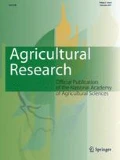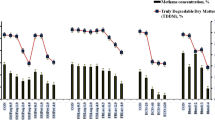Abstract
Seven essential oils (EOs): garlic (Allium sativum), clove (Syzygium aromaticum), lemongrass (Cymbopogon citratus), wild turmeric (Curcuma aromatica), turmeric (Curcuma longa) and cinnamon (Cinnamomum zeylanicum) were evaluated as rumen modifier to mitigate methane emission. The lowest level of EOs tested in this experiment (167 μl l−1 of incubation medium) was the most appropriate level of inclusion as higher doses were detrimental for feed digestibility and fermentation. At this level, methane inhibition was maximum (38.5 %) with garlic oil (GO) followed by cinnamon bark oil (CiBO; 34.9 %), wild turmeric oil (15.5 %), clove bud oil (CBO; 12.9 %), clove leaf oil (8.0 %), lemongrass oil (7.3 %) and turmeric oil (no effect). Feed digestibility was significantly hampered by CBO and CiBO. The response of GO was different from that of other oils as inclusion of GO at 167 μl l−1 of incubation medium resulted in 38.5 % decrease in methane production, significant increase in total volatile fatty acids and propionate production, a decrease in acetate to propionate ratio and had no effect on feed digestibility. All the oils suppressed ammonia production. Partitioning factor, which indicates efficiency of microbial biomass production, was also increased by inclusion of all the seven oils. The CiBO was detrimental for feed fermentation even at the lowest dose of 167 μl l−1 of incubation medium. The data indicated that GO was the most promising feed additive which caused maximum methane inhibition and had the minimum adverse effect on feed digestibility.
Similar content being viewed by others
References
Agarwal N, Shekhar C, Kumar R, Chaudhary LC, Kamra DN (2009) Effect of peppermint (Mentha piperita) oil on in vitro methanogenesis and fermentation of feed with buffalo rumen liquor. Anim Feed Sci Technol 148:321–327
AOAC International (1995) Official methods of analysis of AOAC international, 16th edn. Arlington, VA, USA
Blümmel M, Makkar HPS, Becker K (1997) In vitro gas production: a technique revisited. J Anim Physiol Anim Nutr 77:24–34
Busquet M, Calsamiglia S, Ferret A, Kamel C (2005) Effects of cinnamaldehyde, garlic oil on rumen microbial fermentation in a dual flow continuous culture. J Dairy Sci 88:2508–2516
Busquet M, Calsamiglia S, Ferret A, Carro MD, Kamel C (2005) Effect of garlic oil and four of its compounds on rumen microbial fermentation. J Dairy Sci 88:4393–4404
Busquet M, Calsamiglia S, Ferret A, Kamel C (2006) Plant extracts affect in vitro rumen microbial fermentation. J Dairy Sci 89:761–771
Calsamiglia S, Castillejos L, Busquet M (2006) Alternatives to antimicrobial growth promoters in cattle. In: Garnsworthy PC, Wiseman J (eds) Recent advances in animal nutrition. Nottingham University Press, Nottingham, pp 129–167
Calsamiglia S, Busquet M, Cardozo PW, Castillejos L, Ferret A (2007) Invited review: essential oils as modifiers of rumen microbial fermentation. J Dairy Sci 90:2580–2595
Cardozo PW, Calsamiglia S, Ferret A, Kamel C (2005) Screening for the effects of natural plant extracts at different pH on in vitro rumen microbial fermentation of a high-concentrate diet for beef cattle. J Anim Sci 83:2572–2579
Castillejos L, Calsamiglia S, Ferret A (2006) Effect of essential oil active compounds on rumen microbial fermentation and nutrient flow in in vitro systems. J Dairy Sci 89:2649–2658
Castillejos L, Calsamiglia S, Ferret A, Losa R (2006) Effects of dose and adaptation time of a specific blend of essential oils compounds on rumen fermentation. Anim Feed Sci Technol 132:186–201
Castillejos L, Calsamiglia S, Martín-Tereso J, Ter Wijlen H (2008) In vitro evaluation of effects of ten essential oils at three doses on ruminal fermentation of high concentrate feedlot-type diets. Anim Feed Sci Technol 145:259–270
Davidson PM, Naidu AS (2000) Phyto-phenols. In: Naidu AS (ed) Natural food antimicrobial systems. CRC Press, Boca Raton, pp 265–293
Dorman HJD, Deans SG (2000) Antimicrobial agents from plants: antibacterial activity of plant volatile oils. J Appl Microbiol 88:308–316
Fraser GR, Chaves AV, Wang Y, McAllister TA, Beauchemin KA, Benchaar C (2007) Assessment of the effects of cinnamon leaf oil on rumen microbial fermentation using two continuous culture systems. J Dairy Sci 90:2315–2328
Giordani R, Regli P, Kaloustian J, Mikail C, Abou L, Portugal H (2004) Antifungal effects of various oils against Candida albicans. Potentiation of antifungal action of amphotericin B by essential oil from Thymus vulgaris. Phytother Res 18:990–995
Hammer KA, Carson CF, Riley TV (1999) Antimicrobial activity of essential oils and other plant extracts. J Appl Microbiol 86:985–990
Hosoda K, Kuramoto K, Eruden B, Nishida T, Shioya S (2006) The effects of three herbs as feed supplements on blood metabolites, hormones, antioxidant activity, IgG concentration, and ruminal fermentation in Holstein steers. Asian-Aust J Anim Sci 19:35–41
IPCC (2007) The scientific basis. Cambridge University Press, Cambridge
Jackson W, Krishnamoorthy U, Robinson PH, Fadel JG (2010) Effect of changing partitioning factor (PF) and in vitro rate of gas production (k) of diets on intake and digestibility, microbial N production, as well as milk production and composition, of lactating crossbred dairy cows. Anim Feed Sci Technol 160:128–136
Johnson KA, Johnson DE (1995) Methane emissions from cattle. J Anim Sci 73:2483–2492
Kamel C, Greathead HMR, Tejido ML, Ranilla MJ, Carro MD (2008) Effects of allicin and diallyl disulfide on in vitro rumen fermentation of a mixed diet. Anim Feed Sci Technol 145:351–363
Kim HO, Park SW, Park HD (2004) Inactivation of Escherichia coli O157:H7 by cinnamic aldehyde purified from Cinnamomum cassia shoot. Food Microbiol 21:105–110
Macheboeuf D, Morgavi DP, Papon Y, Mousset J-L, Arturo-Schaan M (2008) Dose–response effects of essential oils on in vitro fermentation activity of the rumen microbial population. Anim Feed Sci Technol 145:335–350
McIntosh FM, Williams P, Losa R, Wallace RJ, Beever DA, Newbold CJ (2003) Effect of essential oil on ruminal metabolism and their protein metabolism. Appl Environ Microbiol 69:5011–5014
Menke KH, Steingass H (1988) Estimation of the energetic feed value obtained by chemical analysis and in vitro gas production using rumen fluid. Anim Res Develop 28:7–55
Patra AK, Kamra DN, Agarwal N (2010) Effects of extracts of spices on rumen methanogenesis, enzyme activities and fermentation of feeds in vitro. J Sci Food Agric 90:511–520
Tiziana Barrata M, Damien Dorman HJ, Deans SG, Cristina Figueiredo A, Barroso JG, Ruberto G (1998) Antimicrobial and antioxidant properties of some commercial essential oils. Flavour Fragr J 13:235–244
Van Soest PJ, Robertson JB, Lewis BA (1991) Methods for dietary fiber, neutral detergent fiber and nonstarch polysaccharides in relation to animal nutrition. J Dairy Sci 74:3583–3597
Wallace RJ (2004) Antimicrobial properties of plant secondary metabolites. Proc Nutr Soc 63:621–629
Walsh SE, Maillard JY, Russell AD, Catrenich CE, Charbonneau DL, Bartolo RG (2003) Activity and mechanisms of action of selected biocidal agents on gram-positive and -negative bacteria. J Appl Microbiol 94:240–427
Wanapat M, Cherdthong A, Pakdee P, Wanapat S (2008) Manipulation of rumen ecology by dietary lemongrass (Cymbopogon citratus Stapf.) powder supplementation. J Anim Sci 86:3497–3503
Wheatherburn MW (1967) Phenol-hypochlorite reaction for determination of ammonia. Anal Chem 39:971–974
Acknowledgments
The research Grant provided by NAIP, ICAR, New Delhi, is gratefully acknowledged and the senior author thanks Director, IVRI, Izatnagar for providing fellowship during the tenure of his PhD programme.
Author information
Authors and Affiliations
Corresponding author
Rights and permissions
About this article
Cite this article
Pawar, M.M., Kamra, D.N., Agarwal, N. et al. Effects of Essential Oils on In Vitro Methanogenesis and Feed Fermentation with Buffalo Rumen Liquor. Agric Res 3, 67–74 (2014). https://doi.org/10.1007/s40003-014-0092-z
Received:
Accepted:
Published:
Issue Date:
DOI: https://doi.org/10.1007/s40003-014-0092-z




